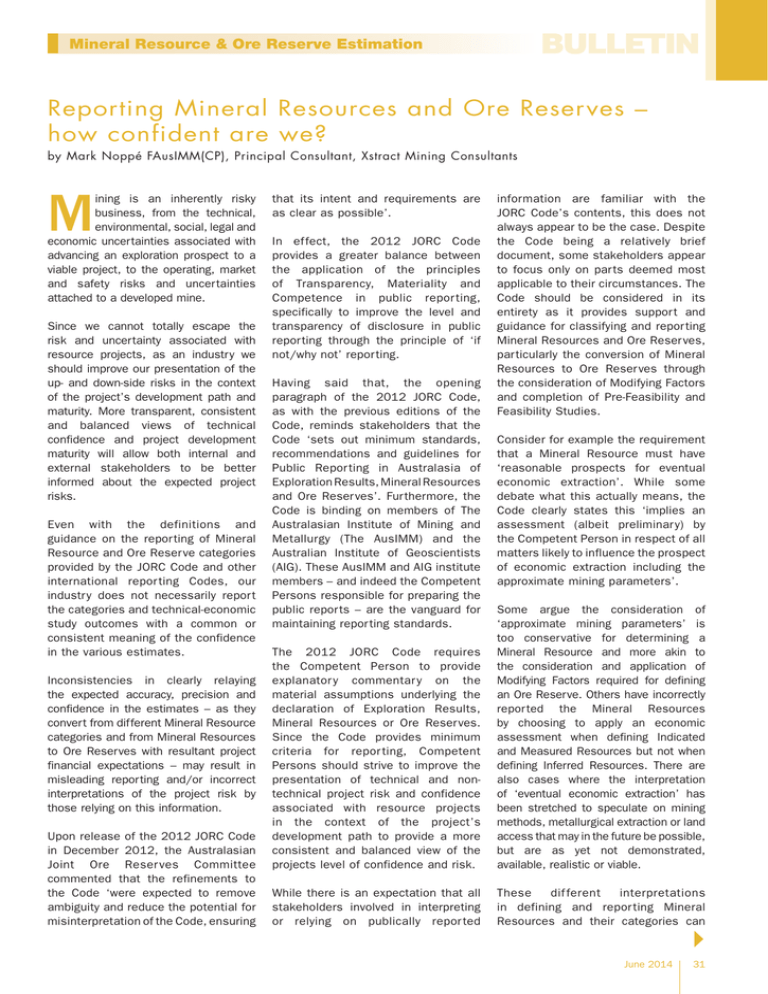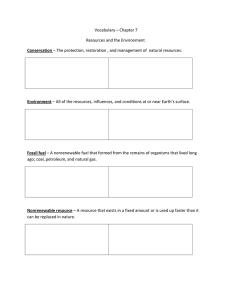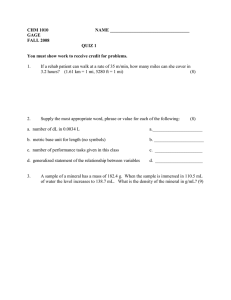Reporting Mineral Resources and Ore Reserves – how confident
advertisement

Mineral Resource & Ore Reserve Estimation Reporting Mineral Resources and Ore Reserves – how confident are we? by Mark Noppé FAusIMM(CP), Principal Consultant, Xstract Mining Consultants M ining is an inherently risky business, from the technical, environmental, social, legal and economic uncertainties associated with advancing an exploration prospect to a viable project, to the operating, market and safety risks and uncertainties attached to a developed mine. Since we cannot totally escape the risk and uncertainty associated with resource projects, as an industry we should improve our presentation of the up- and down-side risks in the context of the project’s development path and maturity. More transparent, consistent and balanced views of technical confidence and project development maturity will allow both internal and external stakeholders to be better informed about the expected project risks. Even with the definitions and guidance on the reporting of Mineral Resource and Ore Reser ve categories provided by the JORC Code and other international repor ting Codes, our industr y does not necessarily report the categories and technical-economic study outcomes with a common or consistent meaning of the confidence in the various estimates. Inconsistencies in clearly relaying the expected accuracy, precision and confidence in the estimates – as they convert from different Mineral Resource categories and from Mineral Resources to Ore Reserves with resultant project financial expectations – may result in misleading reporting and/or incorrect interpretations of the project risk by those relying on this information. Upon release of the 2012 JORC Code in December 2012, the Australasian Joint Ore Reser ves Committee commented that the refinements to the Code ‘were expected to remove ambiguity and reduce the potential for misinterpretation of the Code, ensuring that its intent and requirements are as clear as possible’. In effect, the 2012 JORC Code provides a greater balance between the application of the principles of Transparency, Materiality and Competence in public repor ting, specifically to improve the level and transparency of disclosure in public reporting through the principle of ‘if not/why not’ reporting. Having said that, the opening paragraph of the 2012 JORC Code, as with the previous editions of the Code, reminds stakeholders that the Code ‘sets out minimum standards, recommendations and guidelines for Public Repor ting in Australasia of Exploration Results, Mineral Resources and Ore Reser ves’. Furthermore, the Code is binding on members of The Australasian Institute of Mining and Metallurgy (The AusIMM) and the Australian Institute of Geoscientists (AIG). These AusIMM and AIG institute members – and indeed the Competent Persons responsible for preparing the public reports – are the vanguard for maintaining reporting standards. information are familiar with the JORC Code’s contents, this does not always appear to be the case. Despite the Code being a relatively brief document, some stakeholders appear to focus only on parts deemed most applicable to their circumstances. The Code should be considered in its entirety as it provides support and guidance for classifying and reporting Mineral Resources and Ore Reser ves, particularly the conversion of Mineral Resources to Ore Reser ves through the consideration of Modifying Factors and completion of Pre-Feasibility and Feasibility Studies. Consider for example the requirement that a Mineral Resource must have ‘reasonable prospects for eventual economic extraction’. While some debate what this actually means, the Code clearly states this ‘implies an assessment (albeit preliminar y) by the Competent Person in respect of all matters likely to influence the prospect of economic extraction including the approximate mining parameters’. The 2012 JORC Code requires the Competent Person to provide explanator y commentar y on the material assumptions underlying the declaration of Exploration Results, Mineral Resources or Ore Reser ves. Since the Code provides minimum criteria for repor ting, Competent Persons should strive to improve the presentation of technical and nontechnical project risk and confidence associated with resource projects in the context of the project’s development path to provide a more consistent and balanced view of the projects level of confidence and risk. Some argue the consideration of ‘approximate mining parameters’ is too conservative for determining a Mineral Resource and more akin to the consideration and application of Modifying Factors required for defining an Ore Reserve. Others have incorrectly repor ted the Mineral Resources by choosing to apply an economic assessment when defining Indicated and Measured Resources but not when defining Inferred Resources. There are also cases where the interpretation of ‘eventual economic extraction’ has been stretched to speculate on mining methods, metallurgical extraction or land access that may in the future be possible, but are as yet not demonstrated, available, realistic or viable. While there is an expectation that all stakeholders involved in interpreting or relying on publically repor ted These dif ferent interpretations in defining and repor ting Mineral Resources and their categories can June 2014 31 Mineral Resource & Ore Reserve Estimation result in materially different Mineral Resource categories, quantities and grades being reported for the same deposit by different Competent Persons. While the JORC Code does not prescribe how a Competent Person should carr y out their assessments, the Code provides definitions and guidance to facilitate consistent reporting in order to avoid – or at least support and explain – such obvious differences in interpretation. Consider another general example, namely the definition in the 2012 JORC Code that Ore Reser ves are derived from the Indicated and Measured por tions of a Mineral Resource through the consideration and application of Modifying Factors assessed at the level of at least a Pre-Feasibility Study. This does not necessarily mean that all the Measured Resources will automatically convert to Proved Reserves, or the Indicated Resources to Probable Reserves. The study must demonstrate a technically achievable and economically viable mine plan and schedule for the reported Ore Reserves. Furthermore, the level of confidence in the relevant Modifying Factors must be sufficient to support the category of Ore Reserve. It is therefore possible for only a portion of the Mineral Resource to convert to an Ore Reserve to reflect the uncer tainty in the delineation process. It is also possible that a lower level of confidence in even one key Modifying Factor may mean the relevant portion of the Measured Resource may be better classified as a Probable Reserve than a Proved Reserve, or the Indicated Resource may not convert to an Ore Reserve at all. This downgrade in reported confidence recognises and reflects the material impact of that even one key Modifying Factor may have on the technical, environmental, social, legal and economic viability of the project at the time of reporting and has been allowed for in the 2012 JORC Code (Figure 1). Further clarification on the reporting of Ore Reser ves is provided in clause 28 of the 2012 JORC Code, which states that the words ‘ore’ and ‘reser ves’ are only appropriate to use when all relevant Modifying Factors have been considered and that ‘reports and statements should continue to refer to the appropriate categor y or categories of Mineral Resources until technical feasibility and economic viability have been established’ and extraction can be reasonably justified at the time of reporting’. The Code further expands that ‘if re-evaluation indicates that the Ore Reser ves are no longer viable, the Ore Reser ves must be re-classified as Mineral Resources or removed Exploration Results Mineral Resources Ore Reserves from Mineral Resource/Ore Reser ve statements’. Such re-classification is not intended to result from short-term or temporar y changes in assumptions or operating conditions that may be reasonably expected to revert to the original assumptions within say a few months. The 2012 JORC Code suggests examples of such situations might include commodity price fluctuations expected to be of short duration, mine emergency of a nonpermanent nature, transport strikes and the like. The 2012 JORC Code provides extensive guidance on the relative hierarchy of accuracy or confidence in reporting Mineral Resource and Ore Reser ve categories and technical studies. While the Code does not insist the relative accuracy and confidence level of estimates are described, it strongly encourages Competent Persons to discuss and provide a statement of the relative accuracy and confidence level, or at least a qualitative discussion of the relevant uncertainties. Indeed the 2012 JORC Code frequently refers to the impor tance of the Competent Person’s assessment of confidence in reporting through the use of various terms, such as: ‘accuracy’, ‘uncertainty’, ‘reliability’, ‘confidence’, ‘confidence level’, ‘quality of data’, ‘quality of information’ and ‘quality of repor ted results’. The author interprets the meaning of ‘accuracy’ to encompass both accuracy (lack of bias) as well as precision (repeatability) when it refers to certainty, reliability, confidence, etc. Inferred Increasing level of geological knowledge and confidence Indicated Probable Measured Proved Consideration of mining, processing, metallurgical, infrastructure, economic, marketing, legal, environment, social and government factors (the “Modifying Factors”). Figure 1. General relationship between Exploration Results, Mineral Resources and Ore Reserves (JORC Code, 2012). 32 June 2014 As a principle-based Code, the JORC Code relies explicitly on the Competent Person to provide explanatory commentary on the material assumptions underlying the declaration of Exploration Results, Mineral Resources or Ore Reserves. For example, clause 32 in the 2012 JORC Code states: ‘The choice of the appropriate category of Ore Reserve is determined primarily by the relevant level of confidence in the Mineral Resource and after considering any uncertainties in the consideration of the Modifying Factors.’ Mineral Resource & Ore Reserve Estimation The Code relies on the Competent Persons to provide their own interpretation of what is meant by confidence and accuracy levels in the context of their project and – in the author’s opinion – this requires better disclosure of the expected accuracy and confidence in reported Inferred, Indicated and Measured Resources, Probable and Proved Reserves and indeed the technical and financial outcomes of Scoping, Pre-Feasibility and Feasibility Studies. The interrelationship of increasing certainty and expected project value with advancing development stages, including Resource and Reserve definition and the level of technical-economic study, is presented schematically in Figure 2. When discussing and repor ting accuracy and confidence levels it is highly desirable that the measures and terminology consider the practical use and interpretation of the results for the various stakeholders. In particular, stakeholders wish to appreciate the expected accuracy, precision and confidence levels over a particular period of time. For example, the period of time may relate to a mine production scale, such as the confidence for monthly, quarterly, annually or life-ofmine periods; or whether the confidence relates to a Resource block, selective mining unit, mining panel or strip, or the entire Resource domain. The following examples for reporting the expected accuracy and confidence limits for Mineral Resources and Ore Reser ves would be considered to be meaningful to various stakeholders, including mine operators and management, investors and financiers: •• Measured Resource (or Proved Reserve): ±10 to 15 per cent (at 90 per cent confidence limits) for three monthly production scale parcels •• Indicated Resource (or Probable Reser ve): ±10 to 15 per cent (at 90 per cent confidence limits) for annual production scale parcels. In other words, these metrics imply that one out of 20 periods is expected to be less than 90 to 85 per cent of the estimate and one out of 20 periods may be 10 to 15 per cent higher than the estimate. Alternatively the measures could be reported over the same period or scale but with different accuracy ranges. Clearly the accuracy and level of confidence that can be attained depends very much on the nature of the deposit under consideration. For example, Resource estimates for a nuggetty gold deposit may never attain the same measure of relative confidence as a stratiform-style copper deposit. However, that is exactly the point: no two deposits are identical and that is why further clarification is required to appreciate the actual meaning of a particular Resource or Reserve category. For example, it may be possible to express the same intended accuracy, say ±10 to 15 per cent accuracy for Measured Resources, for various deposit styles but for different scales or periods of production. In other words, it may be possible to achieve this accuracy over three month production areas for a stratiform base metal deposit, but over a six months or one year periods for a nickel sulfide deposit, or over the full life-of-mine for a nuggety gold deposit. Without transparent and consistent repor ting to suppor t the Mineral Resource and Ore Reser ve assumptions, those relying on the Figure 2. The inter-relationship of increasing certainty and project value with advancing development stages and the level of technical study (after Lilford, 2011). June 2014 33 Mineral Resource & Ore Reserve Estimation Public reporting of industrial minerals resources according to JORC 2012 by Andrew Scogings MAusIMM, Industrial Minerals Consultant, KlipStone Pty Ltd Introduction The current edition of the Australasian Joint Ore Reser ves Committee Code (JORC Code) was published in 2012 and after a transition period, came into mandator y operation from 1 December 2013. The 2012 edition has made some significant changes to the requirements regarding the reporting of industrial mineral resources that should be addressed by players in the industrial minerals space. Although the definition of industrial minerals is far from straightfor ward, a commonly used definition is ‘any rock, mineral or other naturally occurring substance of economic value, exclusive of metallic ores, mineral fuels and gemstones: one of the nonmetallics’ (Bates, 1975). Essentially they are minerals and rocks mined and processed for the value of their non-metallurgical properties. Industrial minerals are commonly classified according to their end Continued from page 33 face value of the reported Mineral Resource and Ore Reser ve categories, quantities and grades and study outcomes may not be fully aware of the risks or opportunities inherent in the data and thus may not be in a position to make an informed decision based on the provided information. Conclusion The 2012 JORC Code provides guidance on repor ting other nontechnical matters that may determine an Ore Reser ve: ‘the term ‘Ore Reser ves’ need not 34 June 2014 uses, where there are a diverse (and sometimes bewildering) number of specifications, for example chemical purity, mineralogy, par ticle size distribution, whiteness, density, water absorption, thermal resistance, rheology and insulating properties. This extreme diversity of products and markets can make it difficult for explorers to select appropriate tests and specifications for industrial minerals deposits. Recent interest in industrial minerals sometimes being described for example as ‘the biggest or second biggest in the world’, or ‘world-class’ with perhaps hundreds of millions of tonnes containing a cer tain percentage of a particular mineral. However, being the biggest doesn’t necessarily mean being the best and the author’s intention is to highlight the need to repor t resources by market-related specifications, as such headline claims run the risk of being seen as misleading by investors and regulators. Industrial minerals such as phosphates, potash, graphite and spodumene have recently become the focus of much attention for listed exploration companies, par ticularly the latter two due to developments in batter y technologies related to the emerging electric vehicle and green energy market. Caution should be exercised to ensure that headline and details in public reports reflect the state of knowledge and the viability of successfully developing a resource or reser ve, having taken account of all relevant ‘modifying factors’. In this regard, attention is drawn to CIM (2003) guidelines page 37, where the issue of market size and technical barriers to entr y is addressed: Consequently the race has been on to repor t larger industrial mineral exploration targets and resources, ‘Market considerations incorporate not only the requirement for detailed market analyses and/or contracts of sale, necessarily signify that extraction facilities are in place or operative, or that all necessar y approvals or sales contracts have been received. It does signify that there are reasonable grounds to expect that such approvals or contracts will eventuate within the anticipated time frame required by the mine plans. There must be reasonable grounds to expect that all necessar y government approvals will be received’. reported, it is better to err on the side of providing too much information rather than too little’. The Code goes on to advise that ‘The Competent Person should highlight and discuss any material unresolved matter that is dependent on a third party on which extraction is contingent. If there is doubt about what should be This article is based on the author’s paper ‘Reporting and Converting Resources to Reserves – how confident are we?’, published in the recently released Monograph 30 – Mineral Resource and Ore Reser ve Estimation – the AusIMM Guide to Good Practice (Chapter 9 – Classification and Reporting). References Lilford E L, 2011. Advanced methodologies for mineral project valuation. AIG Bulletin No 53 (Australian Institute of Geoscientists), 41 pages. n


